By Gilad Glick

- Mechanical Stretch due to negative Intra-Thoracic Pressure
Obstructive Sleep Apnea is defined as a physiological event that happens when upper airway is partially or completely blocked during sleep. Mostly, as a result of collapsed soft tissue in the throat while lying on your back. This makes your diaphragm and chest muscles work harder to open the obstructed airway and pull air into the lungs. As the obstruction persists, significant negative pressure is developed in the inner space of the thorax. Breathing usually resumes when the sympathetic nerve system is activated, regaining control over the throat muscles and reopening the airways – ending up with a loud gasp, snort, or body jerk. You may not sleep well, but you probably won’t be aware that this is happening.
Since the heart is “sitting” on the diaphragm on the lower end and attached to the aorta and pulmonary veins in the upper part, this negative intra-thoracic pressure is causing the heart muscle to stretch mechanically, potentially causing micro scarring of the left atrial tissue which in turn promotes arrhythmogenic characteristics (in particular Atrial Fibrillation).
Given that a moderate to severe sleep apnea patients experience Sleep Apnea events between 15 and 60 times an hour, or hundreds of times a night – the accumulated damage can be significant.
- Frequent interruptions to the sympathetic nerve system
As described above, most sleep apnea events end with a surge of the sympathetic branch of the autonomic nerve system. It is also known that the heart electrical system is tightly connected and to some degree regulated by this exact same system. Therefore, it is assumed that the load sleep apnea is imposing on the system has a profound impact on the promotion of irregular electrical activation patterns or arrhythmias.
- Drop in blood oxygen saturation leads to Oxidative Stress
There are serious negative consequences of repetitive oxygen desaturations, also known as Intermittent hypoxia, occurring during Sleep Apnea and affecting the entire cardiovascular system.
“The two most significant are the formation of reactive oxygen species (ROS) and inducing oxidative stress (OS). ROS can damage biomolecules, alter cellular functions and function as signaling molecules in physiological as well as in pathophysiological conditions. Consequently, they promote inflammation, endothelial dysfunction and cardiovascular morbidity. Oxidative stress is also a crucial component in obesity, sympathetic activation and metabolic disorders such as hypertension, dyslipidemia and type 2 diabetes/insulin resistance, which aggregate with OSAHS.”[1]
Another correlation was found between the Apnea/Hypopnea Index (AHI) severity, and Lipid peroxidation, protein oxidation [2], and impaired endothelial function which is a pivotal factor in vascular pathogenesis, which is known to be adversely affected due to the promotion of oxidative stress and inflammation, resulting in educed Nitric Oxide, (NO) availability and thus diminishing its vital vascular repair capacity [3][4].
To learn more about how EPs and cardiologists address sleep apnea in their cardiac care pathway to improve outcomes, quality of life and reduce AFib recurrence – read the article “How Electrophysiologists Reduce AFib Recurrence by Addressing Sleep Apnea”
To learn more about how our Cardio-Sleep customized solutions can help you address Sleep Apnea as part of your cardiac care workflow, while maintaining a positive patient experience and minimal workload on your staff – contact us here.
[1] Lavi et al, Molecular mechanisms of cardiovascular disease in OSAHS: the oxidative stress link. Eur Respir J 2009; 33: 1467–1484
[2] . Hopps et al, Lipid peroxidation and protein oxidation are related to the severity of OSAS. European Review for Medical and Pharmacological Sciences 2014; 18: 3773-3778
[3] Oxidative Stress, and Repair Capacity of the Vascular Endothelium in Obstructive Sleep Apnea
Jelic S, Padeletti M, Kawut SM, Christopher Higgins C, Canfield SM, Onat D, Paolo C. Colombo PC, Basner RC, Factor P, and LeJemtel TH. Circulation. 2008 April 29; 117(17): 2270–2278.
[4] Scherbakov et al, Sleep-Disordered Breathing in Acute Ischemic Stroke: A Mechanistic Link to Peripheral Endothelial Dysfunction. J Am Heart Assoc. 2017 Sep 11;6(9).
